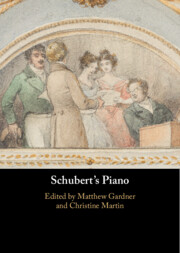Book contents
- Schubert’s Piano
- Schubert’s Piano
- Copyright page
- Contents
- Figures
- Tables
- Music Examples
- Notes on Contributors
- Acknowledgements
- Abbreviations and Conventions
- Introduction
- Part I The Piano in Schubert’s World
- Part II Instruments and Performance
- Part III Sound and Musical Imagery
- Part IV Understanding Schubert’s Writing for the Piano
- 12 Schubert and the Style Brillant: Variation and Figuration in Schubert’s Concertante Chamber Music with Piano
- 13 Rethinking Development and Variation in Schubert’s Last Piano Sonatas: What Do the Drafts and Final Versions Reveal?
- 14 Reflections and Echoes in Schubert’s Waltzes
- 15 ‘Schubert Would Have No Objection if He Knew about It’: Franz Liszt’s Reception of Schubert’s Music
- Select Bibliography
- Index
13 - Rethinking Development and Variation in Schubert’s Last Piano Sonatas: What Do the Drafts and Final Versions Reveal?
from Part IV - Understanding Schubert’s Writing for the Piano
Published online by Cambridge University Press: 31 August 2024
- Schubert’s Piano
- Schubert’s Piano
- Copyright page
- Contents
- Figures
- Tables
- Music Examples
- Notes on Contributors
- Acknowledgements
- Abbreviations and Conventions
- Introduction
- Part I The Piano in Schubert’s World
- Part II Instruments and Performance
- Part III Sound and Musical Imagery
- Part IV Understanding Schubert’s Writing for the Piano
- 12 Schubert and the Style Brillant: Variation and Figuration in Schubert’s Concertante Chamber Music with Piano
- 13 Rethinking Development and Variation in Schubert’s Last Piano Sonatas: What Do the Drafts and Final Versions Reveal?
- 14 Reflections and Echoes in Schubert’s Waltzes
- 15 ‘Schubert Would Have No Objection if He Knew about It’: Franz Liszt’s Reception of Schubert’s Music
- Select Bibliography
- Index
Summary
Historical critiques of Schubert’s methods of development hold that he substitutes ‘genuine’ development with sequences of variation, blurring the boundary between musical progression (development via fragmentation) and additive expansion (repetition via sequence and variation; Adorno 1928, Salzer 1928). Recent appraisals of Schubert’s expansive developmental strategies suggest, alternatively, that the distinction between the two techniques is not as unambiguous as might be assumed (Burstein 1997, Hyland 2013, Martinkus 2018), and have begun to problematise this binary opposition. Building thereon, this chapter brings the continuity drafts and autograph scores for the Piano Sonatas D958, D959 and D960 into focus by paying particular attention to the changes made by Schubert in the final versions, which employ variation or varied repetition as part of an ongoing developmental process. It assesses the impact on formal function and syntax caused by the introduction of varied repeats at different levels of structure, from the individual bar to the full phrase, underlining the resulting amalgamation of sonata (discursive) and variation (recursive) techniques that these works articulate (Ivanovitch 2010). Ultimately, through close examination of Schubert’s compositional revisions, this chapter presents a fuller understanding of what constitutes development in a Schubertian context and the vital role of variation therein.
- Type
- Chapter
- Information
- Schubert's Piano , pp. 259 - 282Publisher: Cambridge University PressPrint publication year: 2024

